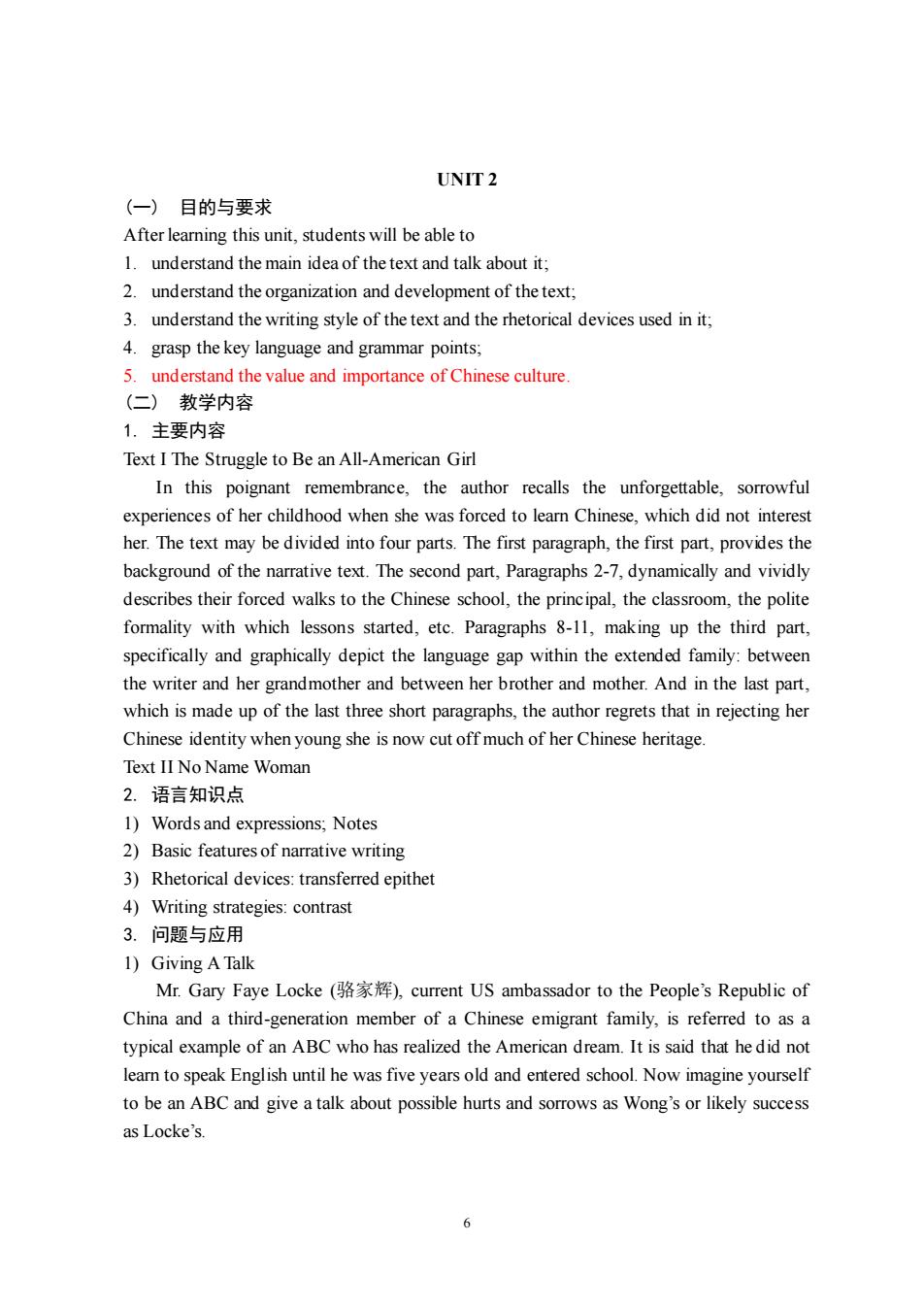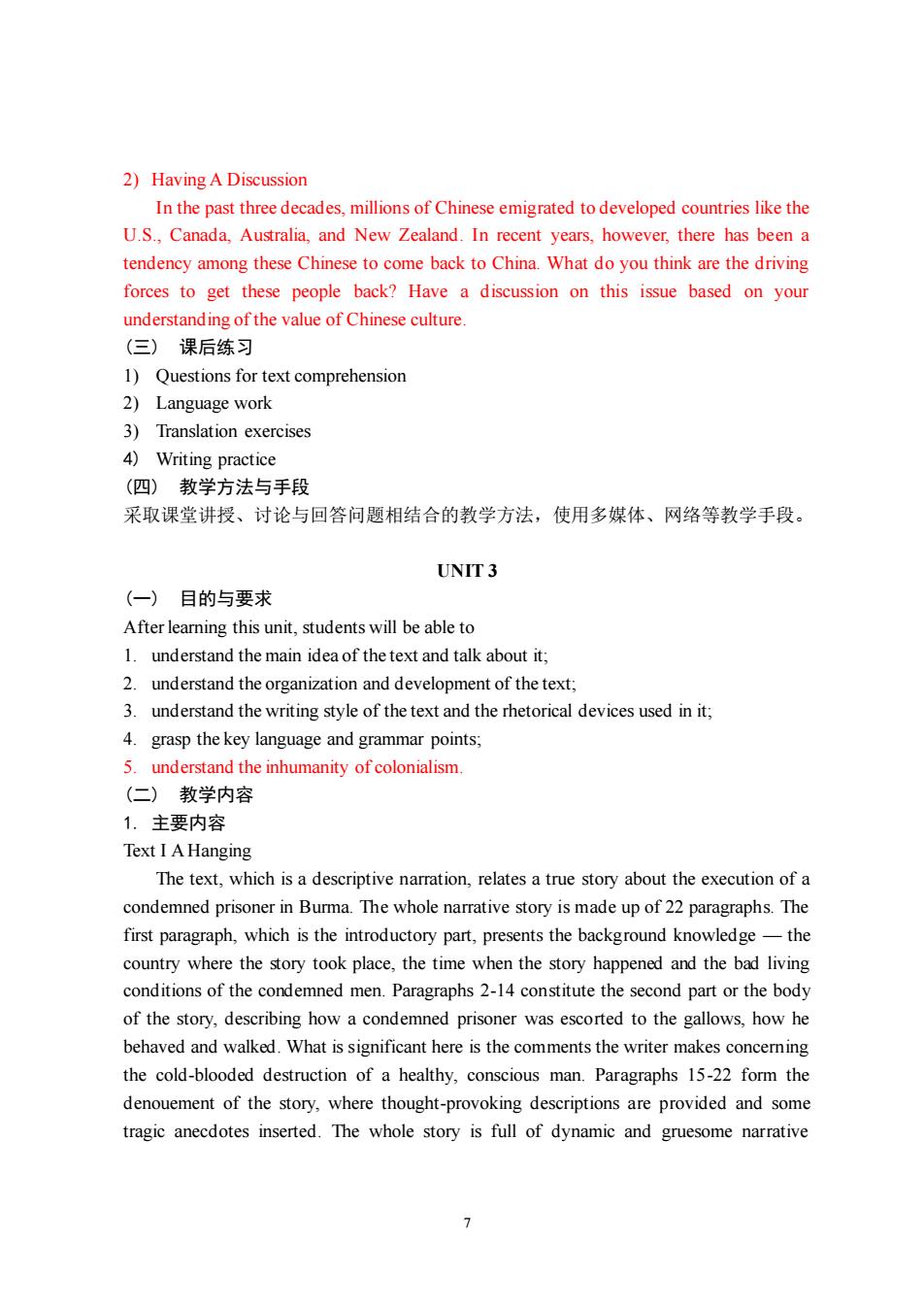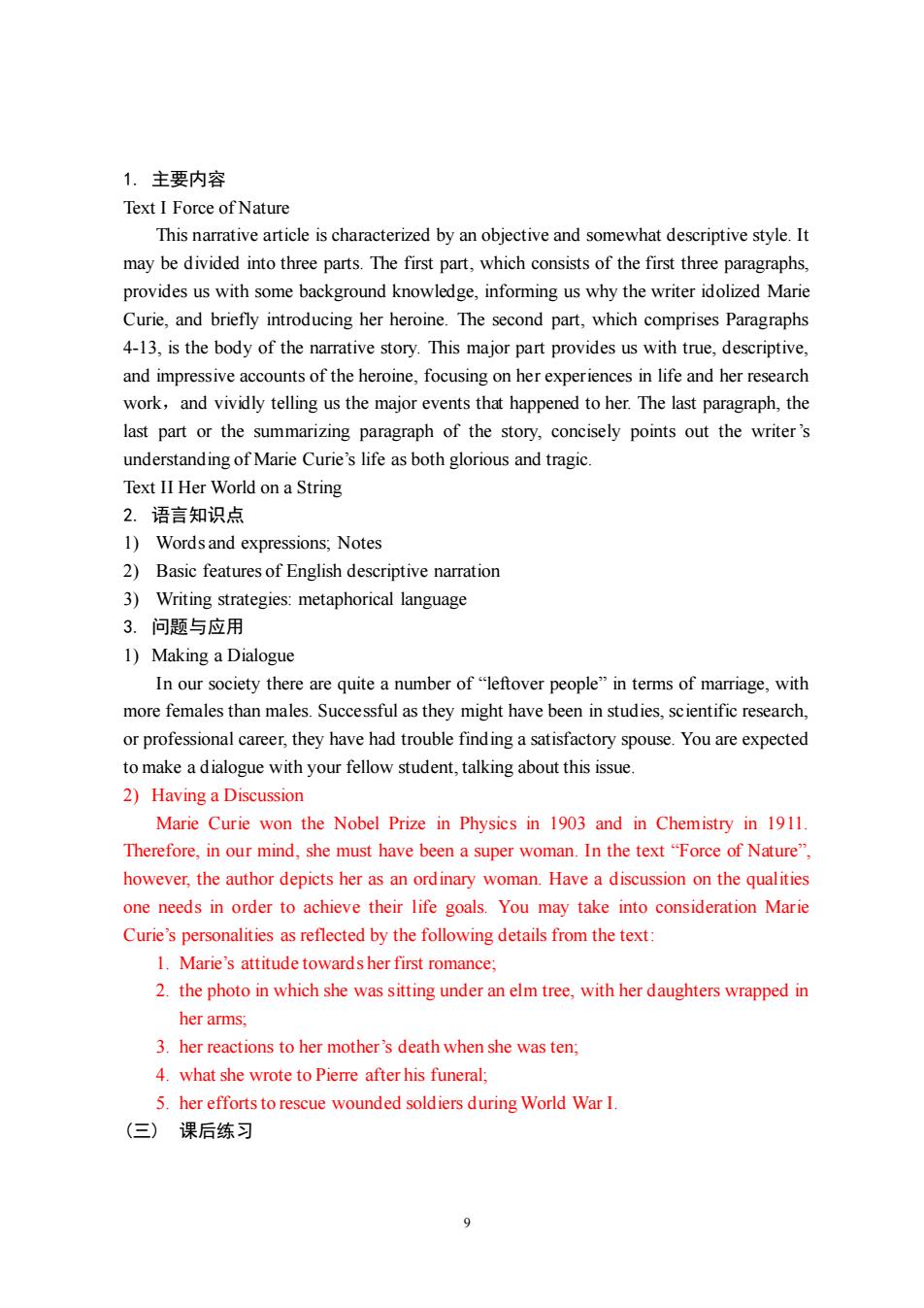
UNIT2 (一)目的与要求 After learning this unit,students will be able to 1.understand the main idea of the text and talk about it; 2.understand the organization and development of the text 3.understand the writing style of the text and the rhetorical devices used in it: 4.grasp the key language and grammar points. 5.understand the value and importance of Chinese culture (二)教学内容 1.主要内容 Text I The Struggle to Be an All-American Girl In this poignant remembrance,the author recalls the unforgettable,sorrowful experiences of her childhood when she was forced to leam Chinese,which did not interest her.The text may be divided into four parts.The first paragraph,the first part,provides the background of the narrative text.The second part,Paragraphs 2-7,dynamically and vividly describes their forced walks to the Chinese school,the principal,the classroom,the polite formality with which lessons started,etc.Paragraphs 8-11.making up the third part specifically and graphically depict the language gap within the extended family:between the writer and her grandmother and between her brother and mother.And in the last part. which is made up of the last three short paragraphs,the author regrets that in rejecting her Chinese identity when young she is now cut off much of her Chinese heritage Text II No Name Woman 2.语言知识点 1)Words and expressions;Notes 2)Basic features of narrative writing 3)Rhetorical devices:transferred epithet 4)Writing strategies:contrast 3.问题与应用 1)Giving A Talk Mr.Gary Faye Locke(g骆家辉),current US ambassador to the People's Republic of China and a third-generation member of a Chinese emigrant family,is referred to as a typical example of an ABC who has realized the American dream.It is said that he did not leam to speak English until he was five years old and entered school.Now imagine yourself to be an ABC and give a talk about possible hurts and sorrows as Wong's or likely success as Locke's. 6
6 UNIT 2 (一) 目的与要求 After learning this unit, students will be able to 1. understand the main idea of the text and talk about it; 2. understand the organization and development of the text; 3. understand the writing style of the text and the rhetorical devices used in it; 4. grasp the key language and grammar points; 5. understand the value and importance of Chinese culture. (二) 教学内容 1. 主要内容 Text I The Struggle to Be an All-American Girl In this poignant remembrance, the author recalls the unforgettable, sorrowful experiences of her childhood when she was forced to learn Chinese, which did not interest her. The text may be divided into four parts. The first paragraph, the first part, provides the background of the narrative text. The second part, Paragraphs 2-7, dynamically and vividly describes their forced walks to the Chinese school, the principal, the classroom, the polite formality with which lessons started, etc. Paragraphs 8-11, making up the third part, specifically and graphically depict the language gap within the extended family: between the writer and her grandmother and between her brother and mother. And in the last part, which is made up of the last three short paragraphs, the author regrets that in rejecting her Chinese identity when young she is now cut off much of her Chinese heritage. Text II No Name Woman 2. 语言知识点 1) Words and expressions; Notes 2) Basic features of narrative writing 3) Rhetorical devices: transferred epithet 4) Writing strategies: contrast 3. 问题与应用 1) Giving A Talk Mr. Gary Faye Locke (骆家辉), current US ambassador to the People’s Republic of China and a third-generation member of a Chinese emigrant family, is referred to as a typical example of an ABC who has realized the American dream. It is said that he did not learn to speak English until he was five years old and entered school. Now imagine yourself to be an ABC and give a talk about possible hurts and sorrows as Wong’s or likely success as Locke’s

2)Having A Discussion In the past three decades,millions of Chinese emigrated to developed countries like the U.S.,Canada,Australia,and New Zealand.In recent years,however,there has been a tendency among these Chinese to come back to China.What do you think are the driving forces to get these people back?Have a discussion on this issue based on vour understanding of the value of Chinese culture. (三)课后练习 1)Questions for text comprehension 2)Language work 3)Translation exercises 4)Writing practice (四)教学方法与手段 采取课堂讲授、讨论与回答问题相结合的教学方法,使用多媒体、网络等教学手段 UNIT3 (一)目的与要求 After leamning this unit,students will be able to 1.understand the main idea of the text and talk about it; 2. understand the organization and development of the text. 3.understand the writing style of the text and the rhetorical devices used in it; 4.grasp the key language and grammar points: 5.understand the inhumanity of colonialism. (二)教学内容 1.主要内容 TextIAHanging The text.which is a descriptive narration.relates a true story about the execution of a condemned prisoner in Burma.The whole narrative story is made up of 22 paragraphs.The first paragraph,which is the introductory part,presents the background knowledge-the country where the story took place,the time when the story happened and the bad living conditions of the condemned men.Paragraphs 2-14 constitute the second part or the body of the story,describing how a condemned prisoner was escorted to the gallows,how he behaved and walked.What is significant here is the comments the writer makes conceming the cold-blooded destruction of a healthy,conscious man.Paragraphs 15-22 form the denouement of the story.where thought-provoking descriptions are provided and some tragic anecdotes inserted.The whole story is full of dynamic and gruesome narrative 7
7 2) Having A Discussion In the past three decades, millions of Chinese emigrated to developed countries like the U.S., Canada, Australia, and New Zealand. In recent years, however, there has been a tendency among these Chinese to come back to China. What do you think are the driving forces to get these people back? Have a discussion on this issue based on your understanding of the value of Chinese culture. (三) 课后练习 1) Questions for text comprehension 2) Language work 3) Translation exercises 4) Writing practice (四) 教学方法与手段 采取课堂讲授、讨论与回答问题相结合的教学方法,使用多媒体、网络等教学手段。 UNIT 3 (一) 目的与要求 After learning this unit, students will be able to 1. understand the main idea of the text and talk about it; 2. understand the organization and development of the text; 3. understand the writing style of the text and the rhetorical devices used in it; 4. grasp the key language and grammar points; 5. understand the inhumanity of colonialism. (二) 教学内容 1. 主要内容 Text I A Hanging The text, which is a descriptive narration, relates a true story about the execution of a condemned prisoner in Burma. The whole narrative story is made up of 22 paragraphs. The first paragraph, which is the introductory part, presents the background knowledge — the country where the story took place, the time when the story happened and the bad living conditions of the condemned men. Paragraphs 2-14 constitute the second part or the body of the story, describing how a condemned prisoner was escorted to the gallows, how he behaved and walked. What is significant here is the comments the writer makes concerning the cold-blooded destruction of a healthy, conscious man. Paragraphs 15-22 form the denouement of the story, where thought-provoking descriptions are provided and some tragic anecdotes inserted. The whole story is full of dynamic and gruesome narrative

descriptions that are impressive and unforgettable Text II Shooting an Elephant 2.语言知识点 1)Wordsand expressions;Notes 2)Basic features of English descriptive narration 3)Writing strategies:dynamic description,first-person narration 3.问题与应用 1)Giving A Talk Reading the text A Hanging,we can feel acutely the helplessness of the victim and the cruelty in terminating a life.People hold sharply contradictory views about the legal killing of criminals who have committed unpardonable crimes.Capital punishment,which is strongly objected to in some countries,abolished in some others,but practiced in still others, is executed in many ways,including hanging.What is your view on this legal practice? Give your reasons. 2)Having A Discussion Hold a discussion on the inhumanity of colonialism as revealed in Orwell's description of the reactions of the witnesses,including the author himself,before,during and after the hanging (三)课后练习 1)Questions for text comprehension 2)Language work 3)Translation exercises 4)Writing practice (四)教学方法与手段 采取课堂讲授、讨论与回答问题相结合的教学方法,使用多媒体、网络等教学手段。 (一)目的与要求 After learning this unit,students will be able to 1.understand the main idea of the text and talk about it; 2.understand the organization and development of the text; 3.understand the writing style of the text and the rhetorical devices used in it. 4.grasp the key language and grammar points; 5.understand the importance of striving for one's life goals (二)教学内容
8 descriptions that are impressive and unforgettable. Text II Shooting an Elephant 2. 语言知识点 1) Words and expressions; Notes 2) Basic features of English descriptive narration 3) Writing strategies: dynamic description, first-person narration 3. 问题与应用 1) Giving A Talk Reading the text A Hanging, we can feel acutely the helplessness of the victim and the cruelty in terminating a life. People hold sharply contradictory views about the legal killing of criminals who have committed unpardonable crimes. Capital punishment, which is strongly objected to in some countries, abolished in some others, but practiced in still others, is executed in many ways, including hanging. What is your view on this legal practice? Give your reasons. 2) Having A Discussion Hold a discussion on the inhumanity of colonialism as revealed in Orwell’s description of the reactions of the witnesses, including the author himself, before, during and after the hanging. (三) 课后练习 1) Questions for text comprehension 2) Language work 3) Translation exercises 4) Writing practice (四) 教学方法与手段 采取课堂讲授、讨论与回答问题相结合的教学方法,使用多媒体、网络等教学手段。 UNIT 4 (一) 目的与要求 After learning this unit, students will be able to 1. understand the main idea of the text and talk about it; 2. understand the organization and development of the text; 3. understand the writing style of the text and the rhetorical devices used in it; 4. grasp the key language and grammar points; 5. understand the importance of striving for one’s life goals. (二) 教学内容

1.主要内容 Text I Force of Nature This narrative article is characterized by an objective and somewhat descriptive style.It may be divided into three parts.The first part,which consists of the first three paragraphs. provides us with some background knowledge.informing us why the writer idolized Marie Curie,and briefly introducing her heroine.The second part,which comprises Paragraphs 4-13.is the body of the narrative story.This major part provides us with true.descriptive. and impressive accounts of the heroine,focusing on her experiences in life and her research work,and vividly telling us the major events that happened to her.The last paragraph,the last part or the summarizing paragraph of the story,concisely points out the writer's understanding of Marie Curie's life as both glorious and tragic. Text II Her World on a String 2语言知识占 1)Words and expressions;Notes 2)Basic features of English descriptive narration 3)Writing strategies:metaphorical language 3.问题与应用 1)Making a Dialogue In our society there are quite a number of"leftover people"in terms of marriage,with more females than males.Successful as they might have been in studies,scientific research, or professional caree,they have had trouble finding a satisfactory spouse.You are expected to make a dialogue with your fellow student,talking about this issue. 2)Having a Discussion Marie Curie won the Nobel Prize in Physics in 1903 and in Chemistry in 1911. Therefore,in our mind,she must have been a super woman.In the text"Force of Nature" however.the author depicts her as an ordinary woman.Have a discussion on the qualities one needs in order to achieve their life goals.You may take into consideration Marie Curie's personalities as reflected by the following details from the text: 1.Marie's attitude towards her first romance; 2.the photo in which she was sitting under an elm tree,with her daughters wrapped in her arms; 3.her reactions to her mother's death when she was ten; 4.what she wrote to Pierre after his funeral; 5.her efforts to rescue wounded soldiers during World War I. (三)课后练习 9
9 1. 主要内容 Text I Force of Nature This narrative article is characterized by an objective and somewhat descriptive style. It may be divided into three parts. The first part, which consists of the first three paragraphs, provides us with some background knowledge, informing us why the writer idolized Marie Curie, and briefly introducing her heroine. The second part, which comprises Paragraphs 4-13, is the body of the narrative story. This major part provides us with true, descriptive, and impressive accounts of the heroine, focusing on her experiences in life and her research work,and vividly telling us the major events that happened to her. The last paragraph, the last part or the summarizing paragraph of the story, concisely points out the writer’s understanding of Marie Curie’s life as both glorious and tragic. Text II Her World on a String 2. 语言知识点 1) Words and expressions; Notes 2) Basic features of English descriptive narration 3) Writing strategies: metaphorical language 3. 问题与应用 1) Making a Dialogue In our society there are quite a number of “leftover people” in terms of marriage, with more females than males. Successful as they might have been in studies, scientific research, or professional career, they have had trouble finding a satisfactory spouse. You are expected to make a dialogue with your fellow student, talking about this issue. 2) Having a Discussion Marie Curie won the Nobel Prize in Physics in 1903 and in Chemistry in 1911. Therefore, in our mind, she must have been a super woman. In the text “Force of Nature”, however, the author depicts her as an ordinary woman. Have a discussion on the qualities one needs in order to achieve their life goals. You may take into consideration Marie Curie’s personalities as reflected by the following details from the text: 1. Marie’s attitude towards her first romance; 2. the photo in which she was sitting under an elm tree, with her daughters wrapped in her arms; 3. her reactions to her mother’s death when she was ten; 4. what she wrote to Pierre after his funeral; 5. her efforts to rescue wounded soldiers during World War I. (三) 课后练习